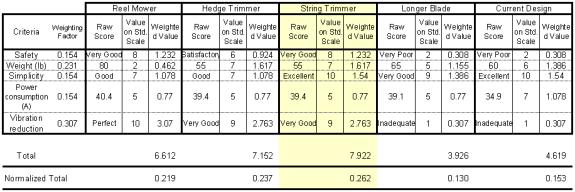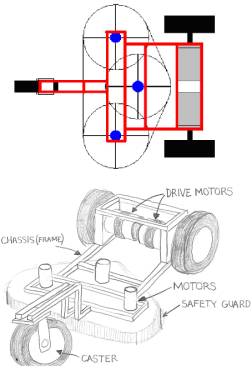
When choosing a concept, things that need to be considered include weight, vibration issues, power consumption and efficiency, and cost. Using estimated weights, the string trimmer and hedge trimmer concepts are the lightest. It is important to keep the mower’s weight down in order to keep the load on the drive wheels as low as possible. In terms of vibration, the longer blade concept appears to be the worst while the reel mower concept seems to be the best. The string trimmer also seems to be a good option because of the elimination of rotating mass.
Power consumption is a very important part of concept selection because longer mower operation translates into more grass being cut. The reel mower concept draws the least amount of current, however, it is the heaviest. In terms of efficiency, it is felt that the string trimmer concept would do the most thorough job cutting grass in a short amount of time even though it consumes more power.
In order to assess the value of each design, pertinent criteria were established for consideration. A rating system was then formed to translate non-quantifiable qualities to a value on a standard scale. Table 2 shows the correlation between the non-quantifiable values and the standard scale.
|
Performance
Level |
Standard
Scale |
Weight
(lbf) |
Consumed
Amps |
|
Perfect |
10 |
40 |
31 |
|
Excellent |
9 |
45 |
32 |
|
Very
good |
8 |
50 |
33 |
|
Good |
7 |
55 |
34 |
|
Satisfactory |
6 |
60 |
35 |
|
Adequate |
5 |
65 |
36 |
|
Tolerable |
4 |
70 |
37 |
|
Poor |
3 |
75 |
38 |
|
Very
poor |
2 |
80 |
39 |
|
Inadequate |
1 |
85 |
40 |
|
Useless |
0 |
90 |
41 |
Table 2: Rating System Correlation between Non-Quantifiable Values and a Standard Scale
After rating the criteria, weighting factors were established for each. The weighting factors were created based on the relative importance to the other criteria. Figure 9 shows how the weighting factors that were attained for the various criteria.

Figure 9: System to Determine the Relative Importance of Each Criterion to Other Criteria
In order to select a concept, the raw scores (see Figure 10) of each criterion were converted to values on the Standard Scale, and then multiplied by the respective weighting factor to get the Weighted Value of the criterion. The weighted values for each concept were added together and then normalized. The concept with the highest normalized total was the concept that was chosen to incorporate into the revised Autonomous Lawnmower and is highlighted in Figure 10.
Concept |
Weight
(lb) |
Consumed
Amps |
|
Reel
Mower |
95 |
23 |
|
Hedge
Trimmer |
70 |
33 |
|
String
Trimmer |
70 |
36 |
|
Longer
Blade |
75 |
30 |
|
Original
Design |
80 |
27 |
Table 3: Tabulated Values of Weight and Consumed Amps

Figure 10: Decision Matrix
As Figure 10 shows, the concept that received the highest score was the string trimmer concept. Though its score is only slightly higher than the score for the hedge trimmer it was felt that the string trimmer is a much more efficient choice for cutting grass. It is not known exactly how well a hedge trimmer design would cut the grass, while there are string trimmers that are specifically designed to cut grass. Ultimately, the string trimmer concept with 3 cutting circles to be the cutting mechanism was chosen for the autonomous lawnmower.

